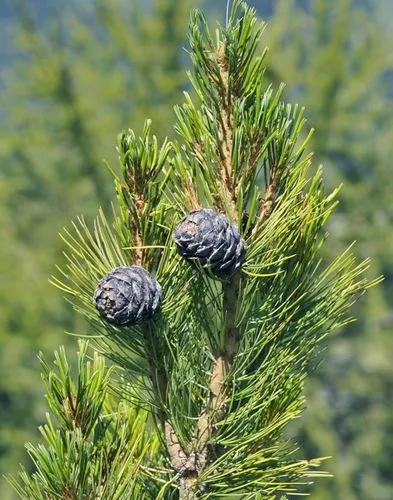Pinus ayacahuite is native to Mexico (from Central Mexico southwards to Chiapas), Guatemala, Honduras and El Salvador. It grows on relatively moist areas with summer rainfalls, however specimens from its eastern and southern distribution live under really wet conditions. Despite its tropical origins, it is surprisingly tolerant of cold, having survived the temperatures down to nearly -30 °C in cultivation. Mexican white pine is a large tree, which reaching up to 50 m tall and 2 m in diameter with straight, round trunk that has pyramidal to conical in shape crown with regular branch whorls. The bark are thin, smooth, and ash-grey on young trees, with age becoming rough, gray-brown, divided into small rectangular plates. The branches are long, slender, and horizontally spreading; lower branches often droop. Their needles are in bundles of 5, slender, flexible, 10 - 15 cm long and 0.7 - 1.0 mm wide, straight or slightly twisted, flexible but not drooping. Pollen cones are yellow when young, turning orange-brown with age. Seed cones are yellow-brown, and quite resinous; ripening in the fall and soon deciduous. The seeds are light brown with dark spots.
Mexican White Pine Care
Pinus Ayacahuite



How to Care for the Plant

Water

It cannot grow in the shade. It prefers dry or moist soil and can tolerate drought.

Pruning

Removal of the lower branches of Mexican white pine is a serious mistake, and, if healthy, they should be retained to the base. Pruning or disbudding can be intelligently performed to add much to the natural symmetry. The extraction or removal, early in spring, of the central or terminal bud, will tend to compel the branches which start from the side buds to spread apart and form a much denser growth. Cutting back the previous year's terminal growth to a strong bud or branchlet on the main limbs over the tree, if the plant is inclined to be thin in its branching, always produces a much denser lateral growth.

Sunlight

Grows best in a sunny position on loamy, well drained soils

Soil

Pinus ayacahuite prefer a well-drained porous gravelly subsoil, overlaid with a light sandy loam. They seem to be particularly happy in a soil underlaid with a porous glacial drift. In cultivation, however, they succeed very well in ordinary well-drained soil. When the plants are set in clay soil, which is often done, the soil should be thoroughly loosened by trenching or subsoil plowing, and well underdrained. Any available humus, woodashes, and well-rotted manure incorporated in the soil greatly aid in rendering it friable and porous for the roots.

Temperature

It grows best in areas where annual daytime temperatures are within the range 17 - 24°c, but can tolerate 9 - 28°c. It can be killed by temperatures of -10°c or lower, with new growth being damaged at -1°c

Additional

The wood, sawdust and resins from various species of pine can cause dermatitis in sensitive people

Popularity

2 people already have this plant 2 people have added this plant to their wishlists
Discover more plants with the list below
Popular articles






